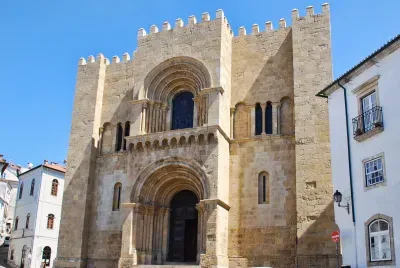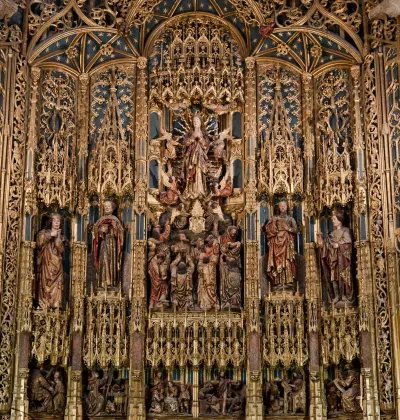
Se Velha - Coimbra Concierge.2C CC BY-SA
Gilded altarpiece - Se Velha Manuelvbotelho CC BY-SA
Porta Especiosa Concierge.2C CC BY-SA
Cloisters - Se Velha Raph CC BY-SACoimbra Old Cathedral
The Sé Velha (Old Cathedral) of Coimbra is said to be the finest example of Romanesque architecture to be found in Portugal. Dating back to the beginning of the 12th century it was built as a statement of the new nation's triumph over the Moors at the Battle of Ourique. Unlike many of Portugal's grand early buildings much of the original Romanesque design remains intact, although there are many subsequent embellishments.
First impressions of the cathedral, particularly from the main façade, can be a little underwhelming. It is somewhat austere resembling a fortress with its thickly buttressed, crenellated walls and narrow windows. However, closer examination will reveal a level of intricacy in the detailing around the main door and windows with their mainly Arabic influenced decor.
Things are a little different on the northern façade which was beautifully remodelled with a Renaissance portal in the 1530s. Named the Porta Especiosa, this three-storey portal was the work of French sculptor João of Rouen. The eastern side of the cathedral also has some interesting features in the form of its three chapels. These are built in a range of styles including Romanesque, Renaissance and Baroque reflecting the eras they were added.
Within the cathedral are the 13th century cloisters built during the reign of Afonso II, Portugal's third king. This attractive space represents the transition of styles from Romanesque to Gothic; each of the pointed arches are distinctly Gothic but contain twin rounded Romanesque style arches.
The churches interior with its barrel-vaulted ceiling is relatively simple until you reach the altar. This consists of an opulently gilded altarpiece created by Flemish craftsmen depicting the birth of Christ, the Assumption and various saints. A second, 16th century Manueline altar stands in the south transept which is the work of João of Rouen.
There are a number of tombs in the cathedral including that of Coimbra's first Christian governor, Sisinado, who was a muslim convert. Perhaps the most interesting tomb is that of Lady Vataça Lascaris, an Italian princess of Byzantine origin. She came to Portugal with Elizabeth of Aragon, who married King Dinis I. Her impressive tomb is decorated with the Byzantine double-headed eagle design.
Address
Largo Sé VelhaCoimbra3000-383Phone
+351 239 825 273Attraction type

Coimbra travel guide »
In terms of historic significance and romantic beauty, Coimbra is second only to Lisbon and Oporto. Its ancient buildings cling to the side of the hill that rises above the curves of the river Mondego, the ornate buildings of the famous University of Coimbra are its crowning glory. Indeed the university is still the lifeblood of the city and the change in atmosphere is notable when the…